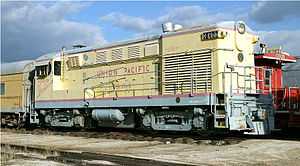FM H-20-44
| FM H-20-44 | |
|---|---|
|
An FM H-20-44 road switcher, retired Union Pacific #1366. | |
| Type and origin | |
| Power type | Diesel-electric |
| Builder | Fairbanks-Morse |
| Model | H-20-44 |
| Build date | June 1947 — March 1954 |
| Total produced | 96 |
| Specifications | |
| AAR wheel arr. | B-B |
| UIC classification | B′B′ |
| Gauge | 1,435 mm (4 ft 8 1⁄2 in) |
| Length | 51 ft 0 in (15.54 m) |
| Locomotive weight | 254,000 lb (115.2 tonnes) |
| Prime mover | FM 38D-10 |
| Engine type | Two-stroke diesel |
| Aspiration | Roots blower |
| Displacement | 10,369 cu in (169,920 cm3) |
| Cylinders | 10 (Opposed piston) |
| Cylinder size | 8.125 in × 10 in (206 mm × 254 mm) |
| Transmission |
DC generator, DC traction motors |
| Performance figures | |
| Maximum speed | 70 mph (113 km/h) |
| Power output | 2,000 hp (1.49 MW) |
| Tractive effort | 42,125 lbf (187.38 kN) |
| Locomotive brake | Straight air |
| Train brakes | Air |
| Career | |
| Locale | North America |
| Disposition | Three preserved, remainder scrapped |
The FM H-20-44 was an multiple unit-capable end cab road switcher manufactured by Fairbanks-Morse from June 1947 – March 1954, and represented the company's first foray into the road switcher market. The 2,000 hp (1,490 kW), ten-cylinder opposed piston engine locomotive was referred to by F-M's engineering department as the "Heavy Duty" unit. It was configured in a B-B wheel arrangement mounted atop a pair of two-axle AAR Type-B road trucks with all axles powered. H-20-44s shared the same platform and much of the same carbody as the lighter-duty FM H-15-44, which began its production run three months later.
In the same manner as other F-M switcher models, the H-20-44 started out displaying a variety of Raymond Loewy-inspired contours, only to have the majority of these superfluous trim features stripped from the last few units built as a cost-cutting measure. Only 96 units were built for American railroads, as few firms saw sufficient value in moving freight in greater quantities or at a higher speeds than was possible with the typical 1,500- and 1,600 horsepower (1,200 kW) four-axle road switchers of the era. Also limiting the model's utility as a true road unit was its lack of a short hood, which the (ironically) lighter-duty H-15-44 did have. Three intact examples of the H-20-44 are known to survive today; all are the property of railroad museums.
Units produced
| Railroad | Quantity | Road numbers | Notes |
|---|---|---|---|
| Akron, Canton and Youngstown Railroad | 6 | 500–505 | |
| Fairbanks-Morse (demonstrator units) | 1 | 2000 | (Builder's #L1032; sold to the UP and assigned #DS1366) |
| New York Central Railroad | 19 | 7100–7118 | |
| Pennsylvania Railroad | 38 | 8917–8942, 9300–9311 | |
| Pittsburgh and West Virginia | 22 | 50–71 | |
| Union Pacific | 10 | DS1360–DS1365, DS1367–DS1370 | |
| 96 |
References
- "Fairbanks-Morse 38D8 Diesel Engine". PSRM Diesel Locomotives. Retrieved January 1, 2006.
- Pinkepank, Jerry A. (1973). The Second Diesel Spotter’s Guide. Milwaukee, WI: Kalmbach Publishing Company. ISBN 0-89024-026-4.
- Kirkland, John F. (November 1985). The Diesel Builders Volume 1: Fairbanks-Morse and Lima-Hamilton. Interurban Press. ISBN 0-916374-69-6.
Further reading
- Sweetland, David R. (1999). Erie-builts and H20-44s: Fairbanks-Morse’s 2,000-Horsepower Pioneers. Withers Publishing, Halifax, PA. ISBN 1-881411-22-2.
External links
- Fairbanks-Morse H20-44 Roster
- Preserved Fairbanks Morse Four-Axle Road Switchers
- Union Pacific #1366 — photo and short history of the second unit built, one of the three surviving FM H-20-44s.
| ||||||||||||||||||||||||||
